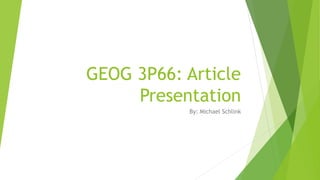Geog 3 p66 article presentation 2
- 1. GEOG 3P66: Article Presentation By: Michael Schlink
- 2. Quick Summary ’üĄ This article is about the dangers of parking lots ’üĄ Parking lots are often places of chaos, confusion and tragedy ’üĄ Car backing into the front of a Costco store (6 people injured) ’üĄ Elderly driver in parking lot in Cranbrook mistook the gas for the brake and crashed into a store ’üĄ Is it the drivers or the parking lot design? ’üĄ Both: People donŌĆÖt care, are in a hurry ’üĄ Reimagining the parking lot ’üĄ Commercial lot: loop ’üĄ Most private lots in Canada donŌĆÖt fall under the jurisdiction of the HTA
- 3. Summary of Lorch (2005) Article ’üĄ As seen within the Lorch (2005) article power centres have become the new enclosed malls ’üĄ They can be built in stages ’üĄ Campus style ’üĄ Pedestrian activity is diminished by: ’üĄ Distance between stores ’üĄ Available parking lot spaces ’üĄ Results of study ’üĄ 92.6% of people have a specific purpose for going to power centre ’üĄ People donŌĆÖt go to leisurely shop. They want to get in and out ’üĄ 41.6% people believe power centres are not safe for pedestrians ’üĄ 90% of the people park their car at least twice ’üĄ Could this study be related to the number of accidents in mall parking lots?
- 4. Questions to Consider ’üĄ Do you believe that it is the planning of the parking lot or the driverŌĆÖs ability causing these high amounts of accidents? ’üĄ Do you think power centers have anything to do with the accidents ’üĄ Compare them to a parking lot at a mall ’üĄ Does a driverŌĆÖs emotion come into play in a power center parking lot? ’üĄ Would there be the same results in a parking lot for Wonderland or the zoo? ’üĄ Why do you think parking lots arenŌĆÖt made for pedestrians? ’üĄ How could it become a more pedestrian friendly environment? ’üĄ How can we as future planners better plan for parking lots in the future in terms of: ’üĄ Safety? ’üĄ Environment? ’üĄ Do you think that if more Canadian parking lots had the Highway Traffic Act involved in collisions this would overall reduce the number of accidents?
- 5. Relation to Loch (2005) Article ’üĄ Relates to auto-dependency of our population ’üĄ We as a population drive everywhere these days and power centres are no exception ’üĄ Going there for a specific reason not to leisurely shop means we want to ŌĆ£get in and get outŌĆØ ’üĄ Whyte Ridge study 92.6% say they go there for a specific reason ’üĄ This could change our driving habits ’üĄ E.g. road rage, fighting for parking spots, speeding in lots ’üĄ Leads to increased chances of accidents in these power centres ’üĄ Study in the U.S. from 2004 to 2009 quotes that 23% of pedestrian-automobile accidents took place in parking lots. ’üĄ Plus making more than two stops (90% in study) would increase the chances of an accident ’üĄ Relates to Grant (2009) article Surrey planner: ŌĆ£Please, if you have a shopping centre, donŌĆÖt make it auto-oriented! LetŌĆÖs cut down the number of parking spaces. LetŌĆÖs bring up the number of shops close to the sidewalk. LetŌĆÖs create a pleasant walking environmentŌĆØ ’üĄ Relates to the pedestrian inaccessibility of power centers ’üĄ These accidents would be a lot less if it were a standard mall ’üĄ People park for an extended period therefore a lot less auto-dependency and less cars driving
- 6. Relation to Course ’üĄ Relates to the change in planning Canada has undergone: ’üĄ Urban growth ’üĄ More focus on parking lot design to reduce accidents ’üĄ Safety ’āĀ relates to High Park ’üĄ Angle parking? ’üĄ Relates to public vs. private sector debate ’üĄ Although most parking lots are private should the government be involved to reduce accidents and fatalities? ’üĄ Highway Traffic Act in Ontario ’üĄ Some main arteries of power centers for public use ’üĄ Traffic Safety Act in Alberta
- 7. Relation to Course ’üĄ Relates to the change in planning Canada has undergone: ’üĄ Urban growth ’üĄ More focus on parking lot design to reduce accidents ’üĄ Safety ’āĀ relates to High Park ’üĄ Angle parking? ’üĄ Relates to public vs. private sector debate ’üĄ Although most parking lots are private should the government be involved to reduce accidents and fatalities? ’üĄ Highway Traffic Act in Ontario ’üĄ Some main arteries of power centers for public use ’üĄ Traffic Safety Act in Alberta






